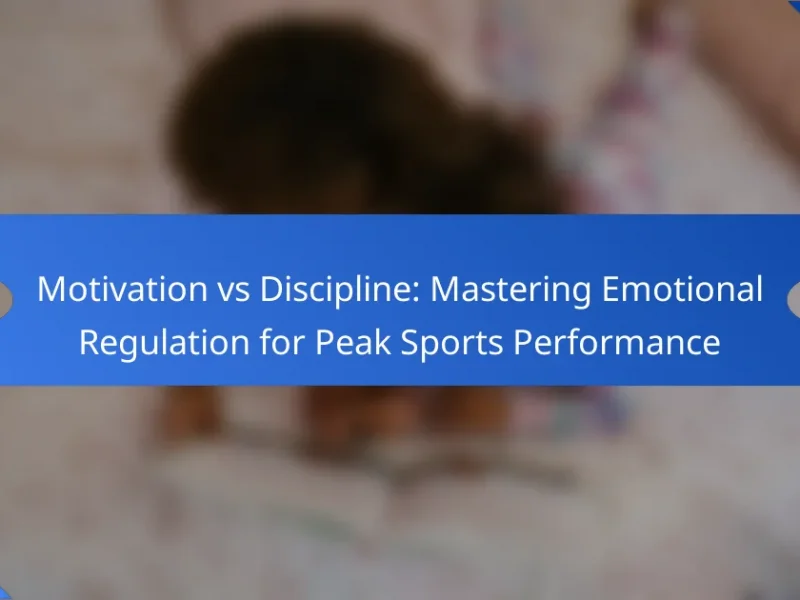Understanding whether it is better for athletes to be loved or feared is crucial for optimal emotional regulation. Love fosters trust, teamwork, and motivation, while fear can lead to anxiety and decreased performance. This article explores the impact of emotional awareness, coping strategies, and support systems on athlete resilience. It also examines how balancing love and fear can enhance performance and create a healthier athletic environment.

Is It Better to Be Loved or Feared in Emotional Regulation for Athletes?
It is generally better for athletes to be loved than feared in emotional regulation. Being loved fosters trust, promotes teamwork, and enhances motivation. Fear can lead to anxiety, decreased performance, and a toxic environment. Research indicates that positive relationships and supportive coaching styles improve athletes’ emotional resilience and overall success.

What are the foundational concepts of emotional regulation in sports?
Emotional regulation in sports focuses on balancing love and fear to enhance athlete performance. Athletes who feel loved often exhibit higher motivation and resilience, while those who are feared may respond with increased pressure and anxiety. Understanding these dynamics is crucial for coaches and athletes to cultivate a supportive environment that fosters optimal performance. Research indicates that positive emotional regulation strategies lead to better team cohesion and individual outcomes. Ultimately, fostering an atmosphere of love can yield more sustainable success than instilling fear.
How do love and fear influence athlete performance?
Love and fear both significantly influence athlete performance, but love often leads to better emotional regulation. Athletes who feel loved experience increased motivation and support, enhancing their focus and resilience. Conversely, fear may induce anxiety, negatively impacting performance. Research indicates that positive emotional states, like love, correlate with improved athletic outcomes, while fear can hinder decision-making and physical execution. Balancing these emotions is crucial for optimal performance.
What are the psychological effects of being loved versus feared?
Being loved is generally more beneficial for emotional regulation in athletes than being feared. Love fosters trust, resilience, and motivation, while fear can lead to anxiety and decreased performance.
Research indicates that athletes who feel supported and valued perform better under pressure. A study showed that positive reinforcement enhances self-esteem and encourages risk-taking in sports, leading to improved outcomes. In contrast, fear-based motivation often results in stress and burnout, negatively impacting mental health.
Ultimately, fostering a loving environment promotes long-term success and well-being for athletes, while fear may yield short-term compliance but can harm their overall performance and emotional stability.
What role does team culture play in emotional regulation?
Team culture significantly influences emotional regulation in athletes. A supportive team environment fosters trust and open communication, enabling athletes to manage their emotions effectively. Research indicates that positive team dynamics enhance emotional resilience, leading to better performance under pressure. Conversely, a toxic culture can heighten stress and anxiety, negatively impacting emotional control. Therefore, cultivating a healthy team culture is essential for optimal emotional regulation in sports.
How does coaching style impact emotional responses?
Coaching style significantly influences athletes’ emotional responses. A coaching approach that balances support and discipline fosters resilience and motivation. Research indicates that athletes often perform better when they feel valued and understood, leading to improved emotional regulation. In contrast, a fear-based approach may yield short-term compliance but can lead to anxiety and reduced performance over time. The optimal coaching style promotes trust and open communication, enhancing athletes’ emotional stability and overall performance.

What are the universal attributes of emotional regulation systems?
Emotional regulation systems in athletes are influenced by both love and fear, but love fosters better performance. Key attributes include emotional awareness, coping strategies, and support systems. Emotional awareness helps athletes recognize their feelings, while coping strategies enable them to manage stress. Support systems, rooted in positive relationships, enhance resilience. Fear-based approaches may yield short-term compliance, but they can lead to anxiety and burnout. In contrast, love-based environments promote motivation and long-term success.
How do emotional regulation strategies affect athlete resilience?
Emotional regulation strategies significantly enhance athlete resilience by fostering a positive mindset. Athletes who effectively manage their emotions can better cope with stress and adversity, leading to improved performance. Research indicates that emotional regulation techniques, such as mindfulness and cognitive restructuring, help athletes maintain focus and motivation during challenging situations. As a result, these strategies contribute to a stronger mental framework, enabling athletes to bounce back from setbacks more effectively.
What common techniques do athletes use for emotional control?
Athletes commonly use techniques such as visualization, mindfulness, and self-talk for emotional control. These methods help manage stress and enhance performance. Visualization involves mentally rehearsing successful outcomes, while mindfulness focuses on present-moment awareness. Self-talk includes positive affirmations to boost confidence. These techniques collectively improve emotional regulation, leading to better athletic performance.

What unique attributes differentiate love and fear as emotional regulation tools?
Love serves as a more effective emotional regulation tool for athletes than fear. Love fosters trust, motivation, and resilience, while fear often leads to anxiety and performance pressure.
Unique attributes of love include its ability to create a supportive environment, enhancing team dynamics and individual well-being. In contrast, fear may produce short-term compliance but can hinder long-term growth and emotional stability.
Athletes motivated by love often exhibit higher levels of engagement and satisfaction. Conversely, those driven by fear may experience burnout and decreased performance over time.
Ultimately, prioritizing love over fear can lead to healthier emotional regulation, fostering a more positive athletic experience.
How does the perception of authority influence emotional responses?
The perception of authority significantly influences emotional responses in athletes, often determining whether they feel loved or feared. Authority figures can evoke respect and compliance, which impacts emotional regulation. For instance, athletes may respond positively to supportive coaches, enhancing motivation and performance. Conversely, fear-based authority can lead to anxiety and decreased confidence, hindering emotional stability. Understanding this dynamic helps in tailoring coaching strategies to foster a more positive emotional environment, ultimately benefiting athletic performance.
What are the unique outcomes of being loved compared to being feared?
Being loved fosters trust and motivation, while being feared creates compliance through intimidation. Love enhances emotional regulation, leading to better performance and teamwork among athletes. Fear may yield short-term results but often results in stress and anxiety, hindering long-term success. Ultimately, love cultivates a positive environment essential for peak athletic performance.
How do different sports cultures perceive love and fear?
Different sports cultures often prioritize love over fear in emotional regulation for athletes. Love fosters trust, teamwork, and motivation, enhancing performance. Fear can lead to anxiety and reduced confidence, negatively impacting athletic outcomes. Research indicates that athletes thriving in supportive environments perform better than those in fear-driven cultures. For example, teams emphasizing positive reinforcement report higher satisfaction and success rates. Ultimately, love cultivates a healthier emotional landscape, crucial for peak athletic performance.

What rare attributes can influence emotional regulation effectiveness?
Emotional regulation effectiveness for athletes can be influenced by rare attributes such as resilience, adaptability, and social support. Resilience allows athletes to recover from setbacks quickly, enhancing emotional stability. Adaptability helps in adjusting strategies during competitions, reducing anxiety. Social support provides a network that fosters positive emotions, crucial for maintaining focus and performance under pressure.
How do individual differences in athletes affect emotional responses?
Individual differences in athletes significantly influence their emotional responses, impacting their emotional regulation strategies. Athletes with high emotional intelligence often respond better to stress, using adaptive strategies like positive self-talk. Conversely, those with lower emotional awareness may resort to maladaptive methods, leading to heightened anxiety. Personality traits, such as resilience and openness, can dictate how athletes perceive pressure, affecting their performance. Tailoring emotional regulation techniques to individual traits enhances overall athlete well-being and performance.
What are some rare strategies used by elite athletes for emotional regulation?
Elite athletes often employ rare strategies for emotional regulation that focus on psychological resilience and performance enhancement. Techniques include visualization, where athletes mentally rehearse successful outcomes to build confidence, and mindfulness practices that enhance focus and reduce anxiety.
Additionally, some athletes utilize biofeedback, which allows them to gain insight into their physiological responses to stress, enabling them to manage emotions effectively. Another unique approach is the use of narrative reframing, where athletes reshape their personal stories to foster a positive mindset and overcome challenges.
These strategies illustrate that emotional regulation in sports is not solely about traditional methods but also involves innovative practices that enhance performance under pressure.

What practical steps can athletes take to balance love and fear?
Athletes can balance love and fear by fostering supportive relationships while managing performance anxiety. Building a strong support system encourages emotional regulation, promoting resilience. Establish clear communication with coaches and teammates to express feelings. Practice mindfulness techniques to reduce fear and enhance focus. Set realistic goals to maintain motivation without overwhelming pressure. Embrace constructive feedback, viewing it as a path to growth rather than fear of failure.
What are the best practices for coaches in emotional regulation?
Coaches should prioritize creating a supportive environment for emotional regulation in athletes. Building trust fosters open communication, enabling athletes to express feelings. Employing techniques like mindfulness and emotional awareness can enhance regulation skills. Additionally, providing constructive feedback helps athletes manage emotions effectively.
What common mistakes should athletes avoid in emotional regulation?
Athletes should avoid several common mistakes in emotional regulation to enhance performance. Overreacting to setbacks can lead to poor decision-making. Ignoring emotions instead of addressing them may result in increased stress. Failing to communicate feelings with teammates can create misunderstandings. Relying solely on external validation can undermine self-confidence. Lastly, neglecting mental recovery practices can hinder emotional resilience.
How can athletes develop a personalized emotional regulation plan?
Athletes can develop a personalized emotional regulation plan by assessing their emotional triggers and responses. This plan should include strategies tailored to individual needs, such as mindfulness techniques, cognitive-behavioral approaches, and goal-setting. Regular self-reflection and adjustments based on performance feedback are crucial for effectiveness. Incorporating support from coaches or sports psychologists enhances the plan’s success, leading to improved mental resilience and performance consistency.


